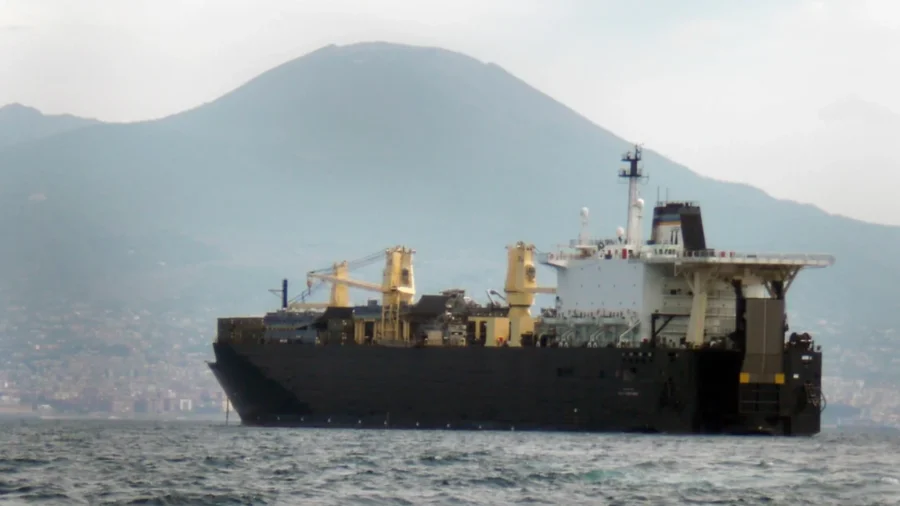A U.S. Navy cargo ship slated to assist in the construction of a pier facilitating humanitarian aid deliveries to the Gaza Strip was forced to abandon the mission and returned to port this week after suffering a fire in its engine room.
The cargo ship USNS 2nd Lt. John P. Bobo suffered a mishap last week when a fire broke out in its engine room, the U.S. Navy confirmed in a statement emailed to NTD News on Thursday.
The ship is an unarmed auxiliary support vessel owned by the Navy and operated by the Military Sealift Command. The roll-on/roll-off style ship was in transit to the eastern Mediterranean Sea to deliver equipment and personnel to assist in the pier construction project, which President Joe Biden ordered last month to increase the flow of humanitarian supplies into the strip.
“The crew evacuated the area and used portable extinguishers to put out the fire. All ship’s crew and military personnel are accounted for, and no injuries were reported,” a Navy spokesperson said.
The Navy spokesperson said the support vessel was able to return to port in Jacksonville, Florida, on Tuesday, April 16 under its own power using one of its two engines.
The cause of the engine room fire is currently under investigation.
The Bobo is one of several ships that have been assigned to assist the pier construction operation, known by the military as a Joint Logistics Over-the-Shore (JLOTS) mission.
The U.S. Army Vessel (USAV) General Frank S. Besson, a smaller logistics support vessel (LSV), was the first U.S. military support vessel assigned to the JLOTS mission. The Army has deployed another LSV, USAV SP4 James A. Loux, for the pier construction mission, along with three even smaller Landing Craft Utility (LCU) vessels, USAVs Monterrey, Matamoros, and Wilson Wharf.
Two additional Navy Bob Hope-Class roll-on/roll-off style cargo ships, USNSs Roy P. Benevidez and 1st Lt. Baldomero Lopez have also been assigned to the pier construction mission.
The Navy spokesperson did not specify how this mishap aboard the Bobo will disrupt the pier construction mission, and whether the ship will be able to rejoin the mission at a later date.
At a Tuesday press conference, Pentagon Press Secretary Maj. Gen. Pat Ryder did not mention the Navy cargo ship mishap or its return to port, but said many of the components for the Gaza pier construction mission “are already in the theater.”
“Based on the information that I have right now, we’re still on track to have JLOTS achieve operating capability by the end of the month or early May,” Maj. Gen. Ryder said.
Maj. Gen. Ryder said observers would likely see construction on the pier beginning in the next two to three weeks.
“What we said when we announced it was that it would be operational within 60 days, and we’re still on track for that,” the Pentagon spokesman added on Tuesday.
The effort to construct a pier along Gaza’s Mediterranean coastline is intended to increase the flow of humanitarian aid to civilians in the territory, as Israeli forces continue their military operation to defeat the Hamas terrorist group.
Last week, U.S. Agency for International Development (USAID) Administrator Samantha Power warned that a state of famine has likely begun in parts of the Gaza Strip.
At a House Foreign Affairs Committee hearing on April 11, Ms. Power said the rate of malnutrition in the Gaza Strip was “almost zero” prior to the start of the current fighting on Oct. 7, but is now “one in three.” She indicated that these rates are likely to worsen as time goes on.
“In terms of actual severe, acute malnutrition for [those under five years old], that rate was 16 percent in January and became 30 percent in February,” she continued. “We’re awaiting the March numbers, but we expect it to get markedly worse.”
Prior to the start of the war, Ms. Power said around 500 truckloads of commercial and humanitarian goods were arriving in the Gaza Strip every day, but fell after the start of the fighting. She said the number of trucks arriving to the Gaza Strip recently hit around 400 a day, but said the months of limited aid deliveries combined with the destruction of food sources within the territory “means we have massive catch-up to do.”

